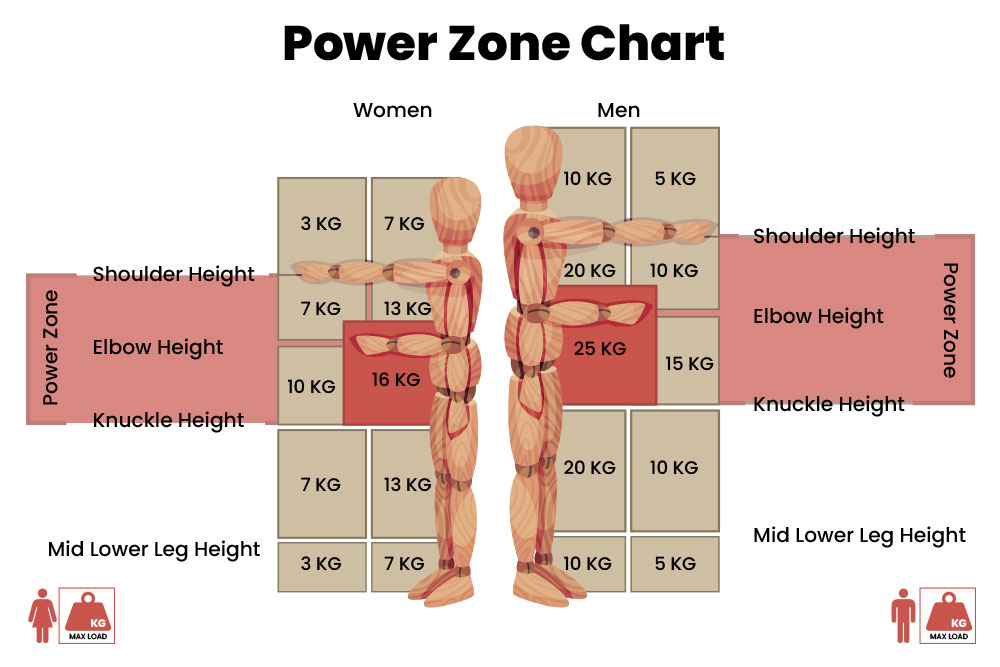
Our bodies are not built for sustained manual handling. We didn’t evolve in warehouses and loading docks. Pushing, pulling and lifting boxes for hours on end is not natural behaviour, and manual handling injury statistics prove it.
So, we have to work smarter. One technique is using your body’s power zone when manual handling. Keeping loads close to your torso in the power zone will help prevent injuries and increase productivity while lifting and carrying.
Our guide explains more about the power zone and other principles for safer manual handling. It will help you lift more, move more and carry more without increasing injury risks.
Manual Handling Risks
Manual handling is inherently risky. Anytime you use bodily force to push, pull, lift, carry or move a load, you risk injury.
Strains, sprains, musculoskeletal disorders and lower back pain are all common issues for workers. According to the Health and Safety Executive (HSE), manual handling injuries are the third most common non-fatal injury type in the workplace.
But even the HSE notes this might be an underrepresentation. Its figures are based on accidents – sudden calamities that result in injury. While manual handling accidents happen, most injuries are the result of repeated, prolonged bouts of lifting without rest, proper technique or equipment. These long-term, nagging injuries aren’t counted in the HSE’s figures.
Injury risks are negligible for one-off lifts of light items, but they increase with the weight and awkwardness of the load as well as the number of lifts. If you oversee or carry out manual handling at work, you (and your employer) have a legal duty to make it safe.

Manual Handling Regulations
All work must be risk assessed under the Management of Health and Safety at Work Regulations 1999.
If a risk related to manual handling is identified, you must comply with the Manual Handling Operations Regulations (MHOR).
MHOR sets out how employers can reduce manual handling injury risks in three steps:
- Avoid manual handling if practical.
- Assess the risks of any unavoidable manual handling.
- Reduce the risk of injury.
Using the power zone when manual handling is one way to reduce injury risks.
Manual Handling Training
Our Manual Handling training course helps users ensure that they are sufficiently trained in the principles and practices of safe manual handling to control and minimise manual handling-related injuries and to ensure a safe workplace for all.
The Power Zone for Manual Handling
It’s safer to carry heavy loads when they’re held in our power zone – the area close to our body, between mid-thigh and mid-chest.
In this position, our back and arms don’t have to work as hard to hold an object. This helps prevent muscle strain and fatigue, which increases injury risks.
A typical man can comfortably carry 20 to 25 kg in his power zone, while a typical woman can carry 13 to 16 kg.
This weight range is shown in the power zone chart featured in the Health and Safety Executive’s manual handling guidance. (We’ve got our own adapted version below.)

Using the Power Zone for Safer Manual Handling
Our ability to safely carry something dips sharply outside of the power zone. This drop-off is shown in the power zone chart.
When planning manual handling tasks, you must consider every zone the load will move through.
For example, a physically fit male could carry a 20 kg load safely if that load could be held in his power zone throughout the task. But if he had to lift the load above shoulder height to place it on a shelf, there would be an injury risk. So, the weight would need to be reduced to 10 kg or the task would need to be redesigned to comply with MHOR.
An object also has to be picked up before it can be carried in the power zone. Bending or stooping puts our lower back at risk, and lifting from the floor without good form is a common cause of injury.
And all weight recommendations assume that the load is stable and easy to grasp with two hands. Loads that are unbalanced, bulky or hazardous to hold won’t be safe to carry in the power zone without adjustments.
Finally, everyone has limits. Even with proper technique and appropriately weighted loads, workers will eventually get tired and be more vulnerable to injury. Repeated movement patterns also cause fatigue to set in fast. Working the same muscle groups without rest is exhausting and potentially harmful.

Other Safe Lifting Techniques
Using the power zone is one technique to reduce injury risks, but reducing injury risks is the least favourable option for making manual handling safe.
The Health and Safety Executive prioritises avoiding manual handling entirely. This ranking is reflected in MHOR, which means you’re legally required to redesign or automate tasks if reasonable – meaning the cost and effort of eliminating manual handling is equal to the injury risks it prevents.
In other words, manual handling is allowed when you can adequately reduce injury risks through other, more straightforward means.
There are multiple control measures that reduce injury risks. You must carry out a risk assessment to determine which are relevant to the task you’re carrying out. However, there are common strategies, including:
- Using mechanical lifting aids.
- Varying work patterns to avoid repetitive tasks and allow rest periods.
- Splitting a load into lighter, more manageable parts.
- Providing grips or handles for awkward items.
- Providing gloves or other protective equipment for sharp materials handling.
- Reducing the distance workers have to carry loads.
- Planning routes around steps or other obstacles.
- Enforcing realistic deadlines and workloads.
Workers must also always be trained. MHOR specifies that all workers receive clear instructions and training on safe manual handling and that any training must be relevant to their work.
Training should also be ongoing. You might assume that workers instinctively know how to lift and carry items safely. But workers can become complacent or simply forget the finer details of proper manual handling techniques. Ongoing training can prevent these issues.
Power Zone for Manual Handling – Key Takeaways
- Keeping loads in the power zone (close to the torso, between mid-thigh and mid-chest) reduces injury risks and increases productivity during manual handling tasks.
- All manual handling tasks must comply with the Manual Handling Operations Regulations. You must avoid, assess and reduce injury risks (in that order) as necessary.
- Recommended weight limits vary based on the load’s position and individual worker. Consider how the worker must hold the load throughout the entire task.
- Control measures include using mechanical aids, splitting loads into manageable parts and providing proper training to workers on safe manual handling practices.
- Continuous training is essential to ensure workers maintain proper manual handling techniques and reduce the risk of injuries.
Manual Handling Training
Using the power zone is critical to safe manual handling, but it’s only one factor. Training is essential for ensuring safe techniques become second nature.
Our online Manual Handling Training courses allow you to learn at your own pace, whenever it suits you. Each course is designed for a specific work environment to ensure the content is practical and relevant. They cover proper technique, using mechanical aids and protecting your back while lifting – all essential risk-reduction strategies for manual workers.





















